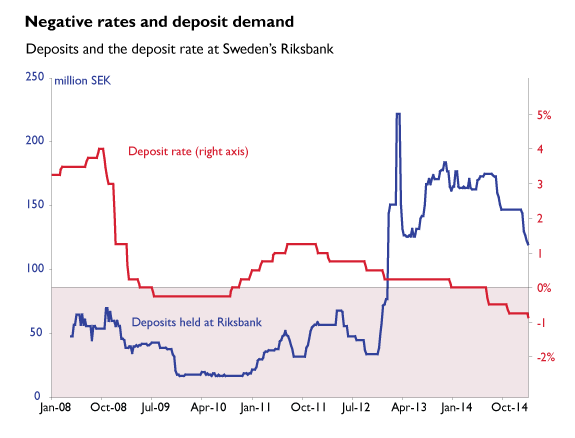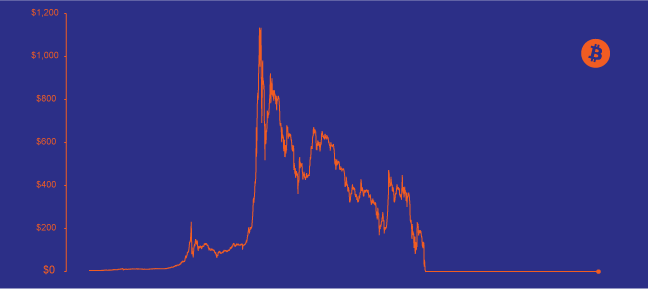The Swedes really don't like cash. First, consider that Sweden is the only country in the world that I'm aware of where reliance on paper money is in decline. Second, no country's central bank has produced a nominal deposit rate as negative as Sweden's, for as long. Yet even at -0.85% per year, Swedish banks who own those deposits haven't fled into 0% cash, providing some indication of the degree to which they hold banknotes in disdain.
ABBA won't accept paper
As the chart below shows, cash outstanding continues to grow in almost every country except Sweden. Japan and Denmark are the only countries that come close to pacing the Swedes, although both nations continue to show incremental growth in demand for banknotes. Even Kenya, where m-pesa has taken hold, shows strong cash demand.
Sweden reached "peak-cash" somewhere between 2007 and 2008. The reason for this change of heart is public preferences, not government diktat. The monetary authorities can only indirectly influence the demand for cash, say by introducing/removing various banknote denominations, or altering the quality of its note issue (say by making notes harder to counterfeit). By virtue of deposits being convertible into cash whenever the depositor desires (and vice versa), the allocation between cash and deposits is primarily up to the public, not the monetary authorities.
One theory is that Sweden become more law-abiding in 2008, thus reducing their demand for paper kronor. Cash is typically demanded by criminals and tax evaders to avoid creating a paper trail. That Sweden's underground element suddenly decided to go legit doesn't seem very plausible to me. Demographics is a more likely contributor to peak cash. As a nation's population growth slows, the demand for cash peters off with it. This can't be the entire explanation, however, since other countries that also suffer from poor population growth profiles (like Canada) show rising cash demand. This leaves technology as the most likely culprit. As electronic payment options improve, it makes little sense to endure the hassle of withdrawing and holding a small horde of dirty paper in one's wallet.
According to a MasterCard study, 89% of transactions in Sweden are cashless, compared to 80% in the U.S. Situation Stockholm, the street paper sold by homeless vendors in Sweden's capital, can be purchased with a card rather than cash, and while London's buses went cash-free earlier this year, bus fares disappeared several years ago in Stockholm. Unlike the U.S. and other laggards, Sweden has a near real-time person-to-person payments system called Bankgirot which has been active since 2011. Bank customers can download an app called Swish, which allows them to make immediate mobile payments over the Bankgirot network. In southern Sweden, Vicar Johan Tyrberg has installed a card reader to make it easier for worshipers to make offerings. And finally, despite having a hit song entitled Money, Money, Money, ABBA refuses refuses to accept cash at the ABBA Museum. Apparently ABBA member Bjorn Ulvaeus is leading a crusade against banknotes after his son's apartment was burgled twice.
No zero lower bound, at least not yet
As a second illustration of Swedish cash abhorrence, consider that no other central bank has maintained a negative deposit rate as low as Sweden's central bank, the Riksbank, for as long. The Riksbank reduced its deposit rate to -0.85% this month after having maintained it at -0.75% since October 2014. A few nations come close. The Swiss, for instance, reduced rates to -0.75% in January, as have the Danes—but both are behind the pace set by the Swedes.
The key point here is that with Riksbank deposits being penalized 0.85% per year, one would assume that that they'd be quickly converted into Swedish banknotes. Cash, after all, pays 0% a year, superior to -0.85%. But that hasn't happened. As the chart below shows, cash left on deposit at the Riksbank stands at around 150 million kr, roughly the same level it has been at for the last twelve months (and far above 2008-2012 levels).
Who keeps funds on deposit at the Riksbank? As the business day progresses and Swedes make payments among each other, banks who maintain settlement accounts at the Riksbank will find themselves in a surplus or deficit position. While those in surplus can elect to park their excess at the Riksbank's overnight deposit facility, they'll usually try to lend these positions to deficit banks in the interbank lending market or participate in Riksbank fine-tuning operations at the end of the day, both of which provide superior returns to the deposit rate. For whatever reason, Swedish banks typically leave a small portion of their surplus in the deposit facility, bearing the awful return on deposits for the sake of enjoying whatever conveniences the deposit facility offers.
That this 150 million kr in -0.85% yielding deposits hasn't been converted into cash is an indication of just how low Swedish opinion on cash has sunk. Consider the myriad number of costs a bank that wants to cash out its balance will have to incur. A Brinks truck must be hired in order to transport the cash to the bank's vaults. The cash must be counted, requiring a diversion of tellers' resources from other important activities. With the majority of Swedish bank branches having gone cashless, they may need to reinvest in handling infrastructure before they can take delivery of a truck full of banknotes. Next, that cash needs to be vaulted, which means displacing other valuables from being safeguarded (like a client's jewels), forcing the bank to forfeit a vaulting fee. Finally, the cash needs to be insured from theft. No wonder Swedish banks continue to use the Riksbank's deposit facility, even at a -0.85% rate; like the public, banks don't consider cash to be a convenient option.
Could Swedes one day re-embrace cash?
Swedes are proud of their move towards digital payments, but this trend could very rapidly come to an end. In an effort to hit its inflation target, the Riksbank may have to push interest rates even deeper into negative territory. At much lower levels, even the most cash-hating Swedes will have to re-consider their aversion to paper. The consequences could be significant. While only a small quantity of deposits are kept in the Riksbank's deposit facility, much larger amounts—around 30 billion krone—are invested at the Riksbank via overnight fine-tuning repos, which currently pay -0.2%. If the Riksbank reduced the fine-tuning rate much lower (say to around -1.5%), these repos would be rapidly converted into cash by banks. The public holds many hundreds of billions more worth of deposits at Swedish commercial banks. Should Riksbank rate reductions force banks to respond by ratcheting down their own deposit rates to -1 or -2%, how long before Swedes empty out their bank accounts, turning Sweden into a cash-only economy?
To avoid reverting to a cash-only economy at extreme negative rates, the Riksbank would do well to hitch itself to the cashless trend. One way to go about this without calling in all banknotes would be to reign in the number of paper products the central bank currently offers consumers, in particular high denominations of notes. Just stop allowing conversions into the 1000 krona note, and maybe the 500 krona note too, or consider canceling these large denominations outright. Not only would this reduce the central bank's printing costs, but it would provide more room for further rate cuts into negative territory—without the threat of a mad dash into Swedish cash.
As for the rest of us...
As in Sweden, I'm pretty sure that cash demand in places like Canada and the US will eventually peak as continued advances in payments technology and a more rapid adoption of those technologies lead consumers to demand less of the stuff. Central banks might consider adapting to this trend ahead of time by reducing the number of paper products they offer to the public. Do the Swiss really need a 1000 SFr note? Do Europeans need a €500 note, and Canadians $100 notes? Alternatively, why not do what Bill Woolsey advocates? Let's gradually privatize the issuance of paper currency. If anyone can make cash relevant again, it's innovators in the private sector. And if they can't, then maybe the banknote deserves to die a slow death.
Secondly, Sweden shows that the so-called zero-lower bound isn't actually at zero, but some distance below that. Cash is awfully burdensome, as evidenced by Swedish banks who are willing to hold deposits at -0.85% despite the option to earn 0%. Central bankers at the Federal Reserve, ECB, and elsewhere would do well to heed this Swedish data point. If they need to loosen monetary policy in order to hit their targets, they can go well below -0.5% before having to fear mass conversion into cash. The world's central bankers have much more interest rate ammunition than they let on.

.gif)
.gif)

